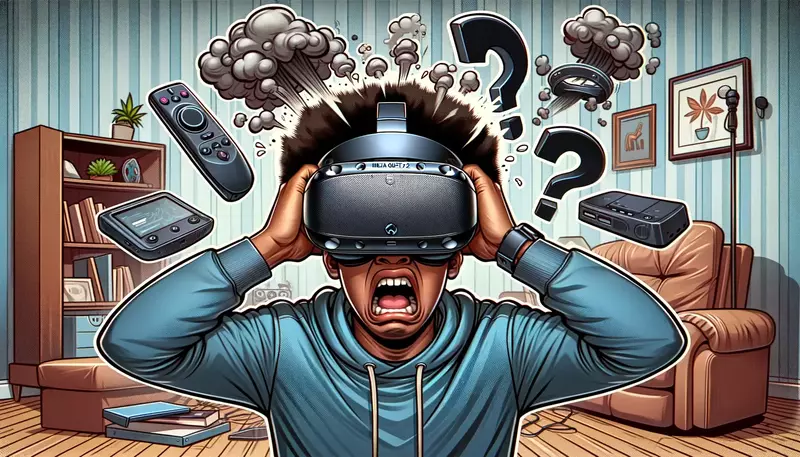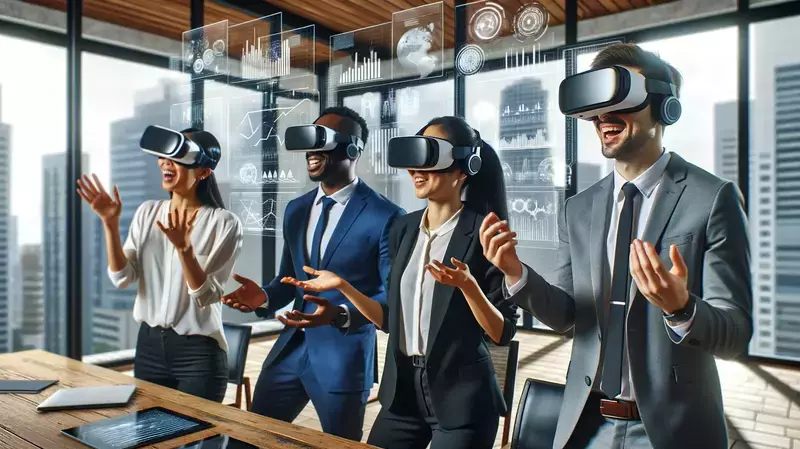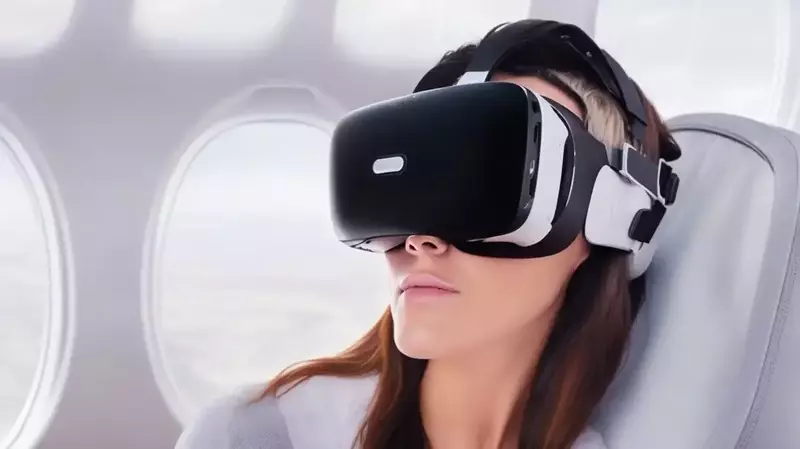This site contains affiliate links to products, and we may receive a commission for purchases made through these links.
As the metaverse continues to expand and evolve, understanding its growth through informative metaverse statistics is essential for anyone interested in virtual reality.
This post dives deep into the metaverse, bringing you informative data and noteworthy insights.
We’ll begin by examining the market size of the metaverse and how it’s estimated to grow over time. Next, we’ll explore key statistics highlighting user engagement, consumer value, and trends within this virtual universe.
Additionally, we will discuss events and shows taking place within the metaverse and how brands leverage this new frontier for innovative marketing strategies.
By further exploring these comprehensive metaverse statistics, you’ll gain a deeper understanding of this fascinating digital realm, rapidly transforming industries such as gaming and beyond.

Market Size of the Metaverse
The global metaverse market has experienced significant growth in recent years, estimated at $7.2 billion in 2023.
This rapid expansion is expected to continue, as projections indicate that the market will be valued at an impressive $19.5 billion by 2027.
This market’s CAGR is expected to be 14.9%, showing a heightened interest and expenditure in virtual reality tech.
Growth Factors Driving the Market
- Technological advancements: The development of more advanced and immersive VR headsets, such as Oculus Quest 2, has made it easier for consumers to access high-quality virtual experiences.
- Increase in digital content consumption: As people spend more time online, there is a growing demand for new forms of entertainment like virtual concerts and gaming experiences within the metaverse.
- Rising popularity among younger demographics: Virtual reality appeals particularly to younger audiences who are eager to explore new worlds and interact with others through social VR platforms like VRChat.
- Pandemic-induced shift towards remote work and communication: With many businesses adopting remote work policies due to COVID-19, employees have turned to VR solutions for collaboration purposes or team-building activities within virtual environments.
Sectors Contributing Most To The Growth Of The Metaverse Market
Different sectors have contributed significantly towards driving this substantial growth in the metaverse market size:
- Gaming: As one of the most popular applications for virtual reality, gaming has played a crucial role in driving consumer interest and adoption. Titles like Beat Saber and Half-Life: Alyx have garnered widespread acclaim and attracted millions of players.
- Social VR platforms: Social platforms such as Rec Room, which allow users to interact with others within virtual environments, have gained popularity among both casual users and dedicated communities.
- Educational experiences: Virtual reality has also been embraced by educational institutions for training purposes or immersive learning experiences, contributing to market growth.
- Retail & e-commerce: Retailers are increasingly using VR technology to offer customers interactive shopping experiences through virtual showrooms or product demonstrations, further expanding the metaverse market size.
The continued expansion of the metaverse market highlights its potential impact on various industries and everyday life. As more people adopt these technologies for entertainment, work, education, or socializing purposes – it’s clear that the metaverse is becoming an integral part of our digital future.
The market size of the Metaverse is constantly growing, and its potential for growth is immense. It’s critical to assess the significant data related to the Metaverse in order to grasp this flourishing sector.
Key Metaverse Statistics
The metaverse has seen a surge in popularity, with many individuals and organizations recognizing its potential. Let’s dive into some key statistics that showcase the current state and future prospects of the metaverse:
- Active Users: It is projected that by 2025, there will be approximately 2.3 billion active users within the metaverse, experiencing a compound annual growth rate (CAGR) of 11%. It is estimated that North America and Europe make up the majority of metaverse users, representing more than 60% of total active participants.
- Gaming Dominance: Gaming remains one of the most popular activities within virtual reality environments. In fact, it is estimated that gaming accounts for around 43% of all consumer spending on VR content, making it a driving force behind the industry’s expansion.
- Social Interaction: Social platforms like Facebook Horizon and VRChat are gaining traction as more people seek immersive ways to connect with others online. According to a report by eMarketer, social interaction ranks as one of the top reasons why consumers use virtual reality devices – second only to gaming.
- Educational Applications: The educational sector has also started embracing virtual reality technology for various purposes such as training simulations or remote learning experiences. A study conducted by PwC predicts that nearly half (48%)of all global job roles could be augmented by VR and AR technology in the future.
These figures indicate the growing acceptance of VR encounters in different fields, as well as among those looking for novel methods to interact with digital material. As more people embrace this immersive technology, we can expect even greater advancements and innovations within the metaverse landscape.
Understanding the key metaverse statistics is essential to understanding the potential of virtual reality. With this knowledge, we can now explore how consumer value plays a role in these developments.
Consumer Value in the Metaverse
Users are discovering a new avenue to break away from their mundane lives and traverse unfamiliar realms through these immersive digital spaces.
As a result, consumer spending on virtual reality products and services is expected to reach $14.5 billion by 2023. This piece will investigate the various elements that have sparked consumer interest in the metaverse.
Immersive Entertainment Experiences
The primary appeal of virtual reality lies in its ability to transport users into fully realized digital worlds that feel almost as real as our own.
This has led to an explosion of innovative entertainment experiences within the metaverse, ranging from gaming and live concerts to interactive storytelling and beyond.
For example, popular VR games like Beat Saber, Half-Life: Alyx, or social platforms such as VRChat have attracted millions of players worldwide who enjoy engaging with others while exploring these richly detailed environments.
Educational Opportunities
Beyond entertainment purposes, many people are discovering that virtual reality can also be an effective tool for learning new skills or enhancing existing ones. Educational institutions are taking advantage of VR technology, allowing students to experience hands-on training through simulations not achievable in a conventional learning environment. For instance, medical students can practice surgical procedures using FundamentalVR, while aspiring architects and designers can create 3D models with tools like IrisVR.
Virtual Socialization and Networking
The metaverse also provides users with new ways to connect with others from around the world. Virtual reality social platforms such as AltspaceVR and Rec Room enable people to meet up, chat, play games, attend events or even collaborate on projects together – all within an immersive digital environment. This has proven particularly valuable during times of social distancing due to the COVID-19 pandemic when many individuals have turned to virtual spaces for human connection.
Fitness and Wellness Applications
Last but not least, consumers are finding value in VR-based fitness and wellness applications that offer unique exercise experiences designed specifically for use within the metaverse.
Programs like Supernatural VR Fitness App combine engaging gameplay elements with expertly curated workout routines set against breathtaking backdrops – making it easier than ever before for users to stay motivated while working towards their health goals.
As consumer interest in virtual reality continues its upward trajectory, we can expect further innovations within this space that cater directly to user needs.
From entertainment experiences tailored toward specific audiences or interests educational opportunities offering hands-on training simulations, virtual networking events, and fitness apps focused on maintaining physical well-being. Undoubtedly, the metaverse is quickly becoming an integral part of our daily lives.
The value to the consumer is a powerful impetus for VR technology, allowing users to experience an immersive and entertaining encounter. Events and shows are a great way to demonstrate this consumer value by showcasing how VR can be used in various applications.
Events and Shows in the Metaverse
The rise of virtual reality has led to increased events and shows dedicated to this immersive technology. These gatherings provide a platform for developers, content creators, hardware manufacturers, and other industry professionals to showcase their latest projects, network with one another, and learn about new trends shaping the metaverse landscape.
Oculus Connect
Oculus Connect is an annual conference hosted by Facebook-owned Oculus VR. At Oculus Connect, attendees from around the globe gather to explore and experience cutting-edge virtual reality technology.
With keynote presentations from industry leaders like Mark Zuckerberg and hands-on demos showcasing cutting-edge VR experiences, Oculus Connect offers a unique opportunity for enthusiasts to stay up-to-date on all things related to the metaverse.
VRLA Expo
The VRLA Expo is another major event that focuses on virtual reality innovation. Held annually in Los Angeles since 2014, VRLA features exhibits from leading companies such as HTC Vive, Samsung Gear VR, Google Daydream Viewer along with panel discussions featuring experts discussing various aspects of VR development including gaming applications or cinematic storytelling techniques within immersive environments.
SVVR Conference & Expo
- Date: TBA (annual)
- Venue: San Francisco Bay Area (USA)
- Description:The Silicon Valley Virtual Reality (SVVR) Conference & Expo, held annually in the San Francisco Bay Area, is another major event that brings together VR professionals and enthusiasts. The conference features keynote speakers from industry giants like Google, Microsoft HoloLens team as well as workshops on various aspects of virtual reality development such as 3D modeling or spatial audio design.
The metaverse community assembles to pass on knowledge, work together on projects, and advance the potential of VR tech. As the metaverse expands, we anticipate further advances in virtual reality technology.
Events and Shows have become an integral component of the virtual realm, allowing people to investigate novel opportunities in the metaverse.
Moving on from this, Brands and Beyond looks at how companies utilize VR technology to reach out to their customers creatively.
Frequently Asked Questions Metaverse Statistics
What are some statistics about the metaverse?
As of 2023, the global market size for the metaverse is estimated to be around $47.69 billion and projected to reach $280.6 billion by 2025. Additionally, over 50% of internet users aged between 16-64 have expressed interest in virtual reality experiences.
How many metaverse users are there statistics?
The number of active users in popular metaverses varies greatly; however, platforms like Roblox boast over 150 million monthly active users while Fortnite has approximately 350 million registered players worldwide.
What percentage of people are interested in the metaverse?
Around 53% of internet users aged between 16-64 years old show an interest in exploring or participating in virtual reality environments such as the metaverse.
!! For more information about the different VR headsets on the market, check out this product specification list.
Conclusion
The metaverse is a rapidly growing industry with no signs of slowing down. With the right investments and understanding, businesses can benefit from this technology in terms of consumer value, events and shows, brands and beyond.
It’s clear that metaverse statistics are essential to fully comprehending its potential for growth as well as how it will shape our future lives. As we continue to explore these possibilities together, let us remember that knowledge is power when it comes to harnessing the full potential of the metaverse market size.

Espen
Espen is the Director of PursuitMeta and has written extensively about Virtual Reality and VR Headsets for years. He is a consumer product expert and has personally tested VR Headsets for the last decade.




Leave a Reply